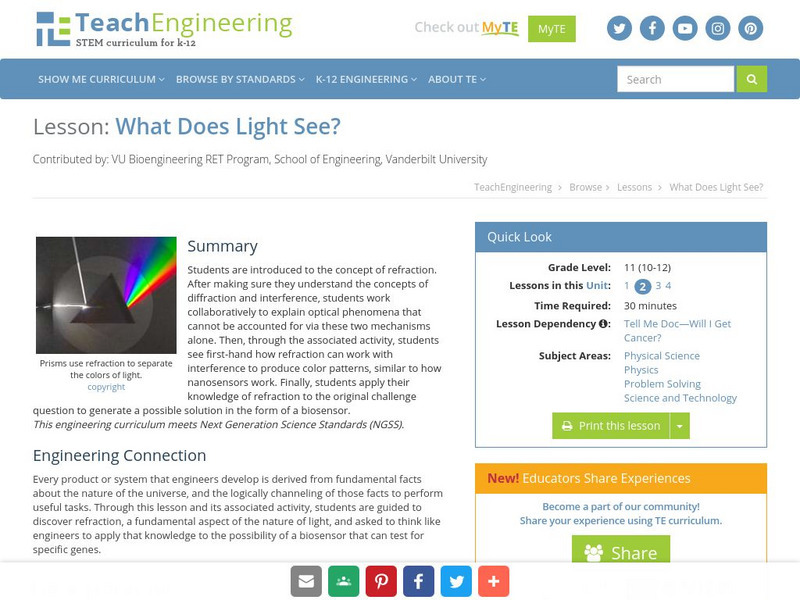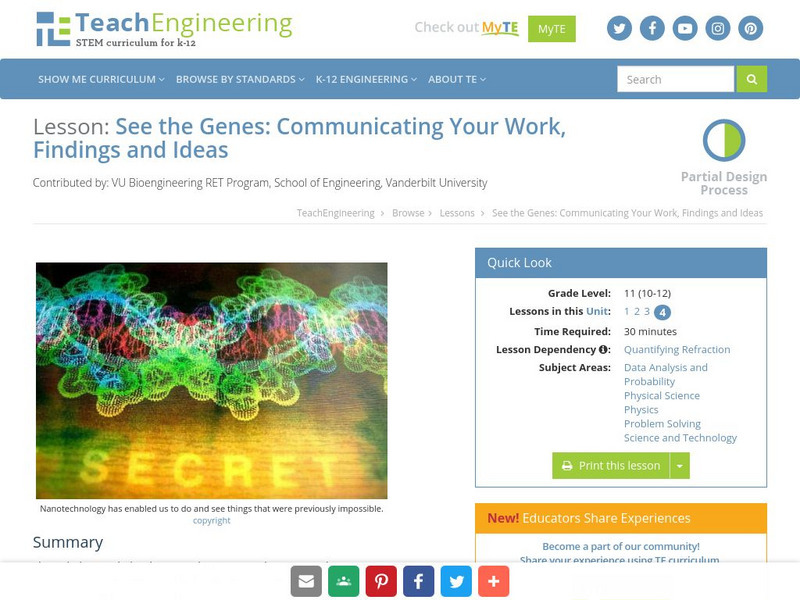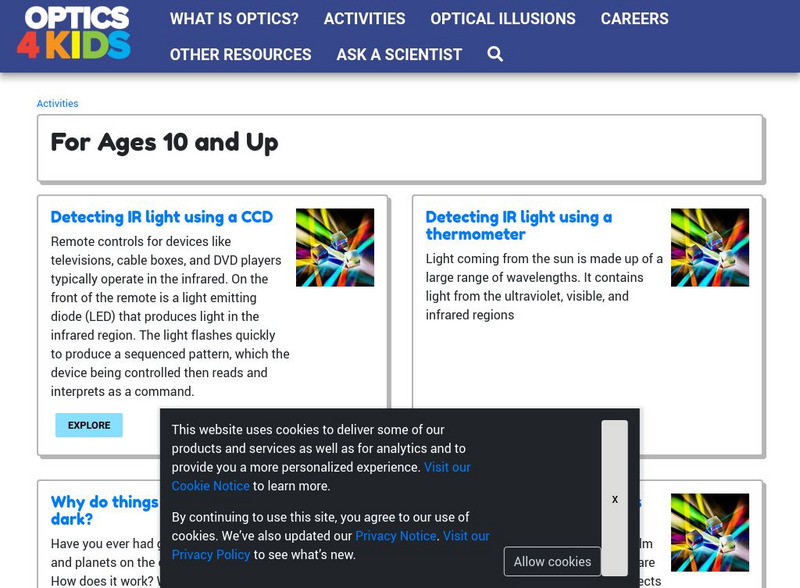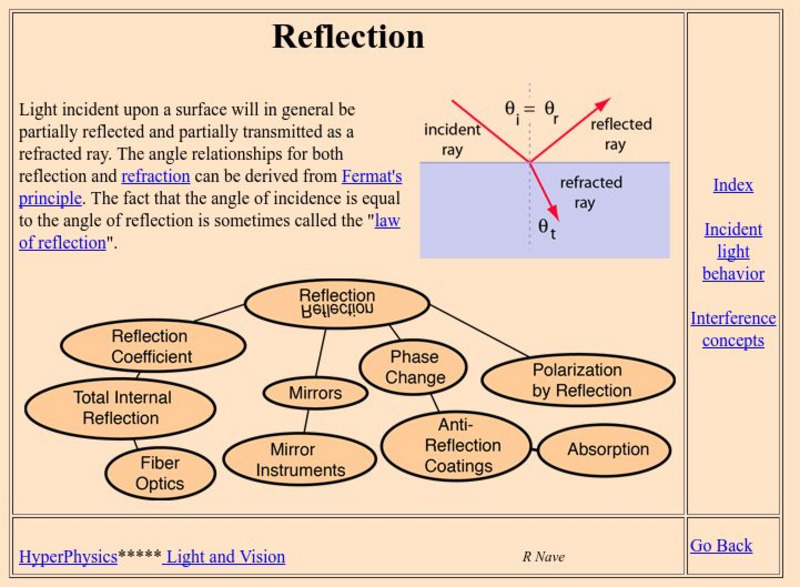TeachEngineering
Teach Engineering: What Does Light See?
Students are introduced to the concept of refraction. After making sure they understand the concepts of diffraction and interference, students work collaboratively to explain optical phenomena that cannot be accounted for via these two...
TeachEngineering
Teach Engineering: See the Genes
Through this concluding instructional activity and its associated activity, students experience one valuable and often overlooked skill of successful scientists and engineers- communicating work and ideas. Students create posters...
TeachEngineering
Teach Engineering: Learning Light's Properties
Students learn the basic properties of light--the concepts of light absorption, transmission, reflection and refraction, as well as the behavior of light during interference. Lecture information briefly addresses the electromagnetic...
Physics Classroom
The Physics Classroom: Wavelike Behaviors of Light
How light waves demonstrate their wave nature by reflection, refraction, and diffraction.
ClassFlow
Class Flow: What Is Light?
[Free Registration/Login Required] This flipchart reviews the characteristics of light and its properties. Students are given examples of reflection, refraction, and lens types. An assessment component is included.
Utah Education Network
Uen: I'm So Bright! I Wear My Shades Indoors!
This lesson engages students in learning about light through multiple sources. Students will learn how light is produced, reflected, refracted, and separated. Students will communicate their findings through an independent project that...
Utah Education Network
Uen: Enlightening Explorations, Part Iii
This lesson contains the following labs: Rainbows, Refraction with Prisms, and What Color Is It? Students will study light by reading various nonfiction texts and viewing a video lesson. Then students will engage in the following labs:...
Utah Education Network
Uen: Enlightening Explorations, Part Ii
This lesson engages students in learning about light. Studets will describe how light is produced, reflected, refracted, and separated.
Physics Classroom
The Physics Classroom: Light Waves and Color
The behavior of light waves is introduced and discussed. Also, polarization, color, diffraction, and interference are introduced and discussed thoroughly as supporting evidence of the wave nature of light.
Vision Learning
Visionlearning: Physics: Light I: Particle or Wave
Instructional module focusing on light. Discussion includes historical development of particle versus wave theories and the scientific studies leading to the understanding of light waves today. Site also includes an interactive practice...
Physics Classroom
The Physics Classroom: The Nature of a Wave
A very good introduction to the world of waves. Waves and wavelike motion, what is a wave, and categories of waves are the topics examined in this site. Many links to other wave sites.
Massachusetts Institute of Technology
Mit: Open Course Ware: Courses: Physics: Electricity and Magnetism
College-level physics course highlighting electromagnetism. This course also includes a wide variety of other physics topics including lightning, electrocardiograms, metal detectors, and atom smashers, to name a few. Course includes a...
Optical Society
Optical Society of America: Optics for Kids: Lenses and Geometrical Optics
Article explaining what lenses are and how they work. At the end of the article, there are links to several hands-on activities for investigating lenses.
Optical Society
Optical Society of America: Exploring Science of Light: Intermediate Activities
A collection of intermediate experiments, for students aged ten and up, for exploring the magnification, reflection, and refraction of light.
University of St. Andrews (UK)
University of St. Andrews: Christiaan Huygens
This University of St. Andrews site contains biographical information and findings of Christiaan Huygens.
PBS
Pbs Learning Media: Observing Refraction of Light
This video segment adapted from Shedding Light on Science illustrates how light changes speed, and thus direction, in a process known as refraction. Includes background reading and discussion questions. [2:05]
CK-12 Foundation
Ck 12: Wave Properties
[Free Registration/Login may be required to access all resource tools.] Students investigate behaviors of waves, including interference, reflection, refraction, and diffraction.
BBC
Bbc: Gcse Bitesize: General Properties of Waves
Light travels as waves. Waves can be described by their amplitude, wavelength and frequency. The speed of a wave can be calculated from its frequency and wavelength.
American Museum of Natural History
American Museum of Natural History: See the Light
Take a look at light with these three easy experiments
Discovery Education
Discovery Education: 3 M Young Scientist Lab: Disappearing Glass
Glass objects seem to disappear when placed in cooking oil.
Discovery Education
Discovery Education: 3 M Young Scientist Lab: Gelatin Optic Fibers
Strips of gelatin dessert and a laser pointer demonstrate total internal reflection.
University Corporation for Atmospheric Research
Ucar: Measuring Density by Bending Light
Young scholars observe how different materials bend light, and how we can infer the nature of the material based on the amount it bends light rays.
Cosmos 4 kids
Cosmos4 Kids: Exploration:telescopes
Learn how telescopes work .. terms like reflection, refraction, different kinds of lens, and more. The brief, to the point text makes this site most suitable for younger researchers.
Georgia State University
Georgia State University: Hyper Physics: Behavior of Incident Light
This site from Georgia State University is an indexing page for several other pages on the topic of reflection. Topics are treated in an understandable manner and utilize meaningful graphics.

















